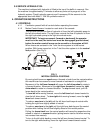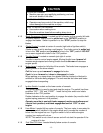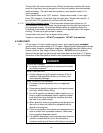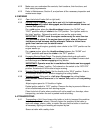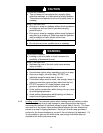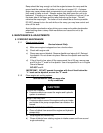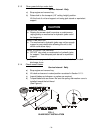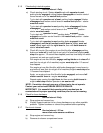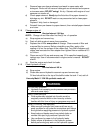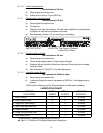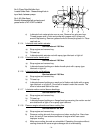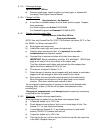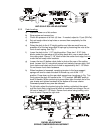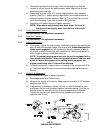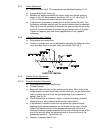
- 22 -
c) Remove foam pre-cleaner element and wash in warm water with
detergent. Rinse until all traces of detergent are eliminated and squeeze
out excess water
(DO NOT wring).
Air dry. Saturate with engine oil and
squeeze out excess oil.
d) Check paper element.
Gently
tap the flat side of the paper element to
dislodge any dirt.
DO NOT
wash or use pressurized air to clean paper
element.
Replace if dirty, bent or damaged.
e) Reinstall foam pre-cleaner to paper element, then reinstall paper element
and cover.
5.1.8 Change engine oil:
Service Interval: 100 hrs
.
NOTE:
Change oil and filter after first five(5) hrs. of operation
a) Stop engine and remove key.
b) Drain oil while engine is warm from operation.
c) Replace the oil filter
every other
oil change. Clean around oil filter and
unscrew filter to remove. Before reinstalling new filter, apply a thin
coating of oil on the surface of the rubber seal. Turn filter clockwise until
rubber seal contacts the filter adapter then tighten filter an additional 2/3
to 3/4 turn.
d) Clean around oil fill cap and remove cap. Fill to specified capacity and
replace cap. Use oil recommended in engine owner’s manual.
DO NOT
overfill.
e) Start the engine and check for leaks.
5.1.9 Check hydraulic oil level:
Service Interval:
40 hr.
a) Stop engine.
b) Clean area around hydraulic reservoir cap and remove cap.
Oil level should be to the top of the baffle inside the tank. If not, add oil.
Use only Mobil 1 15W-50 synthetic motor oil.
WARNING
POTENTIAL HAZARD
♦ Hydraulic fluid escaping under pressure can penetrate
skin and cause injury.
WHAT CAN HAPPEN
♦ Fluid accidentally injected into the skin must be
surgically removed within a few hours by a doctor
familiar with this form of injury or gangrene may result.
HOW TO AVOID THE HAZARD
♦ Make sure all hydraulic fluid hoses and lines are in
good condition an all hydraulic connections and fittings
are tight before applying pressure to hydraulic system.
♦ Keep body and hands away from pinhole leaks or
nozzles that eject high pressure hydraulic fluid.
♦ Use cardboard or paper to find hydraulic leaks.
♦ Safely relieve all pressure in the hydraulic system
before performing any work on the hydraulic system.



